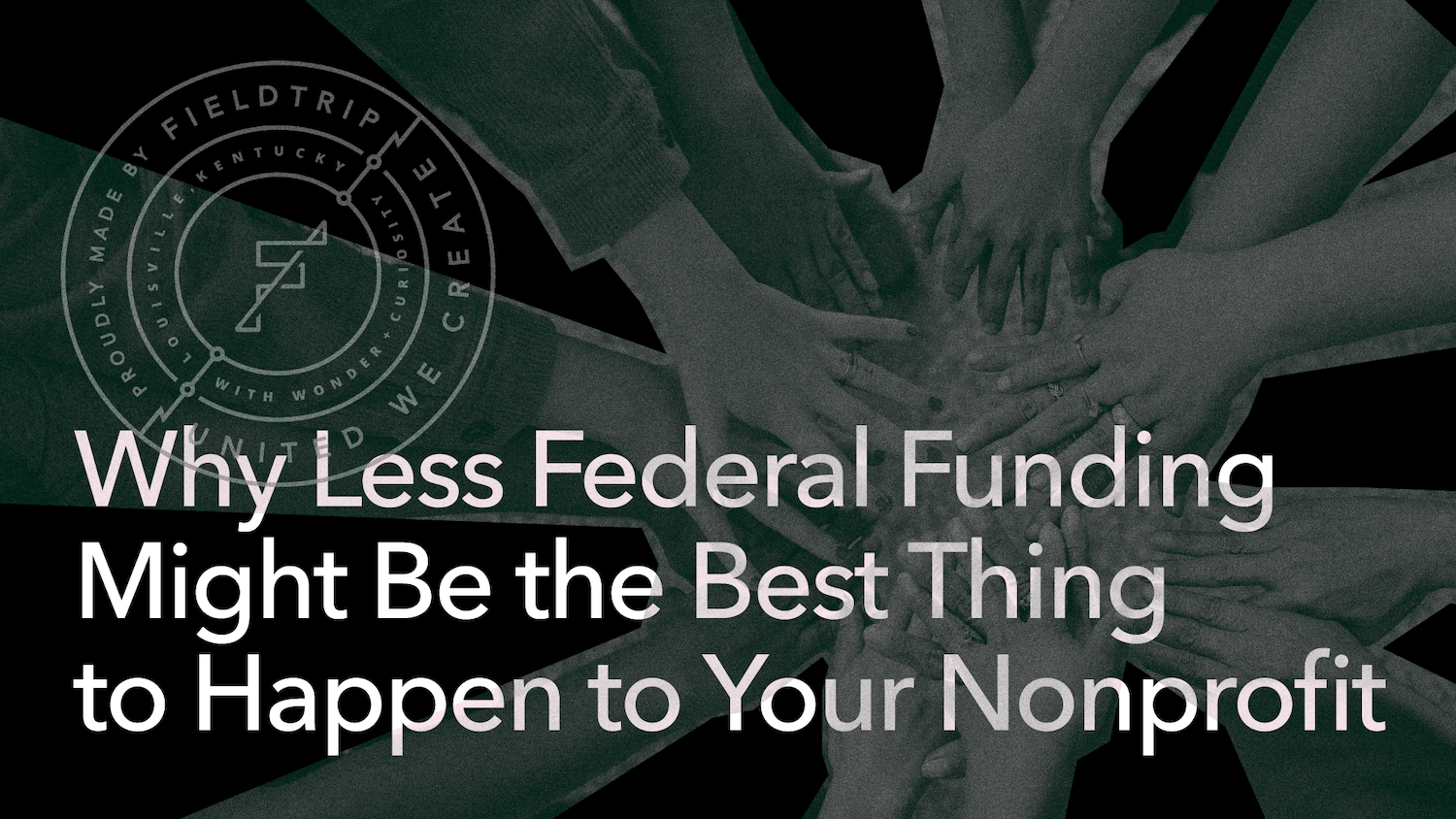Hello and welcome to this week’s edition of Mission Multiplier. I’m Jane Pfeiffer, founder and president of Fieldtrip. Fieldtrip is a marketing and branding firm that helps nonprofits and purpose driven organizations reduce their largest expense. Now, that expense isn’t found on the balance sheet. It’s actually the cost of IDKs. Familiar with those? IDKs are the I don’t knows. I don’t know you. I don’t know what you do. I don’t know if it’s important to me. I don’t know how I can help or why I should care or I don’t know if you can help me. And those IDKs create lost opportunities. And we work with nonprofit leaders to help reduce those lost opportunities and multiply the mission.
Today we’re talking about advocates. Now, a lot of people would call your greatest fans, ambassadors. And that is a good description. But advocate is an action. It’s not just a label or a title. It’s an affirmative action. And that’s what we’re looking for. And are your advocates, are they outcomes of the work that you do or are they assets for your organizations? We’re going to talk about how to know the difference and create as many assets as possible. An outcome is a way that things turn out. It’s an output. You help a young single mother find affordable housing and because of that, she is able to send her kids to school on a reliable basis, look for employment and really just have the pleasure of a safe, comfortable place to sleep and taking that burden off of her shoulders. That is an outcome. Fortunately, she’s probably appreciative of your help and might send others your way. But we don’t know that. And frankly, she doesn’t owe us that. We helped her because it’s the organization’s mission, pure and simple. That situation is an outcome. We do good work. We live our mission, and good things happen for others. And today I’m asking to kind of continue that story. I’m asking you to take this outcome and turn it into an asset for your organization and a mission multiplier. An asset has future benefits. It returns again and again on its inherent value. Let’s be clear. I said it before, but the mother or any outcome of your organization is not an asset. They don’t belong to you. They don’t owe you anything. Their story is not yours to tell unless you nurture such a relationship. And that’s what we’re working on. That advocacy can only be earned and granted, it can’t be assumed. If you recall, the triple-A assessment that we do, advocacy is the third and deepest level of any relationship with either our beneficiaries or our benefactors. Your brand or organization at this level has become part of their identity. They no longer look at you as something they engage with. They look at your brand as a part of them. It’s a part of their identity, who they are, what they’re about, and they’re better because of that relationship. As I said in the beginning, advocacy is an active state. It’s not a state of mind or matter. That’s why I use the word advocacy, even though I know sometimes that’s confusing when we talk about legislative actions or policy. And advocacy is typically a connected to those two things. But Ambassador-ing is not a word and advocacy, and the act of it is what I’m trying to stress. There’s passion, there’s action. And when somebody is ready and willing to be your champion, you have an asset. Again, their advocacy is your asset, not the person or their story. And this is a really sensitive issue for some organizations.
Take the Make-A-Wish Foundation, one of the most well known and respected nonprofits. You know what they do. And yet with a child and a family receive a phenomenal gift. And my son was a recipient. So I know that firsthand. The organization has nothing in return. They don’t ask for you to write a thank you note. They don’t ask for pictures. They don’t ask for you to fundraise. And yet some people, like my son, take their initiative and provide something. And it’s at that point– provide something back to the organization like Make-A-Wish– and it’s at that point that you can have a conversation, whether it’s that point or down the road about advocacy. Would they be willing to help you, or work with you to either share their story or to be a peer counselor to others, or to give critical feedback to the process, their engagement, what their relationship was like, and what that experience was like. Coming back to Make-A-Wish -they actually collected these stories that children and families willingly returned back to them and wrote a book. The book is called Once Upon a Wish: True Inspirational Stories of Make-A-Wish Children. Now it’s for sale on Amazon, but the purpose isn’t really to sell books. The purpose is they use this book as a way of connecting with celebrities or business leaders that might be able to grant a wish and to inspire them about the life changing and incredible memories that can be created as a result of their participation. So it’s an advocacy tool that they have created, not just a coffee table book. So your stories may not fill a book, and I doubt that many of our organizations even would aspire to create such a thing. But you must actively cultivate advocates, and that’s simply done by nurturing relationships. Make it easy for them to share the impact of your work, the impact of the organization on their lives, or just help others come to you and ask for help or give support. So to break this down, here’s a couple steps that you can tackle and hopefully maybe the first one even this week.
So the first thing is to make a list of your current advocates. I’m going to show you an example. Give me just a moment of what that looks like. This is a basic form. It’s even in a Google doc. It doesn’t need to be anything fancy. But this list tells me the name and I would normally put contact information. Obviously this example is fictitious that we do have permission. We consider them an advocate and so does Floyd, our volunteer. In this example, we write a little bit about the connection. How did he become an advocate? What’s the back story? Enough information of what he shared, but not too much. That private information is available to others who might have this list. We know that he’s already volunteering out of appreciation. Now let’s think about how he would best connect. He’s a private man but is comfortable telling his family’s story in a one on one situation and how his adult daughter benefited from substance abuse services. I’ve listed possible internal audiences and external audiences, and that advocacy might show up as showing appreciation at a staff luncheon, writing a thank you note to a donor or just calling another parent when their child has also accepted support for a similar issue. You know, check the box and where you think your advocate would be most relevant and most comfortable. Then think about the assets and again, the person in their story is not your asset, but their willingness to be your advocate is the asset. We have to nurture and protect that willingness and that relationship. So have we captured that story? Do we have a photo of Floyd or a photo of the family? Can we use that on social media? Here’s a list of all the ways, not just with Floyd, but perhaps with any advocate that we could use their story to help others come to us find us, support us, or allow us to help them check the box on the things that would be most relatable to this particular volunteer or advocate. For example, I wouldn’t ask Floyd to host a fundraiser, but I would ask him to maybe have a one on one conversation with maybe someone who’s on the fence as to whether or not they want to write that sponsorship check for our organization.
And then finally, how are we going to nurture that relationship? And we can’t just assume, because Floyd is doing a generous and grateful thing, that we will always deserve that unless we nurture the relationship. Keep in touch, check in, everybody knows his name, all the basic things that we often think about. But do we actually catalog what could happen to make and keep Floyd a valuable advocate? I would create a list of all of these advocates that you can think of. You should look at every category, whether it’s beneficiary, family of beneficiaries, major donors, volunteer staff who tells the story, and have we equip them to tell the right story and have we earn the opportunity to ask them to share with others and bring people towards us? That is advocacy and that’s an asset. So that was step number one. Make a list. Number two is kind of multi-part. One, double down, make sure that you have confirmed their consent. I would document it and make sure that you’ve explained what that means. Can’t just ask them to share a story once and then assume you have access to their story or can call upon them at any time. It doesn’t have to be a complicated conversation, but it does need to be an important conversation. The second part of number two is how long will it take you to increase your list by 10% or 20%? Do you need 30 days? Do you need a quarter? Keep it no more than 90 days, but set a goal of how you can create two or 20 new advocates, whatever that number is.
And then finally, the third step is what are the systems, processes and people that can recognize, Hey, so-and-so might be a great advocate for us because of the conversation I just said, because of their experience, because of X, Y, or Z, you can’t be everywhere in your organization, so you need others to know what to look for and to understand what an asset advocacy is. Don’t make this more complicated than it needs to be. Remember the key steps. First, define a list. Take the time to make it detailed. Think about all the ways in which a strong advocate can benefit your organization and the ways that you can work together to do more good work. Step two is to make sure that you have secured their buy in and consent and that you’ve set expectations for what that may look like and what may be expected and what are the things that they’re not comfortable with. Doesn’t have to be a complicated conversation, but it does need to be a clear and candid conversation. And then what does it take to grow this list by ten or 20%? Make it a short window of time, and then define the processes and people that can help you recruit and nurture the advocates for your organization. The important place is just to get started. Don’t overthink it, but you can’t replace the value of advocacy and organization. It is the most powerful asset that you have when it comes to creating more mission and more benefit and impact to what you do.

